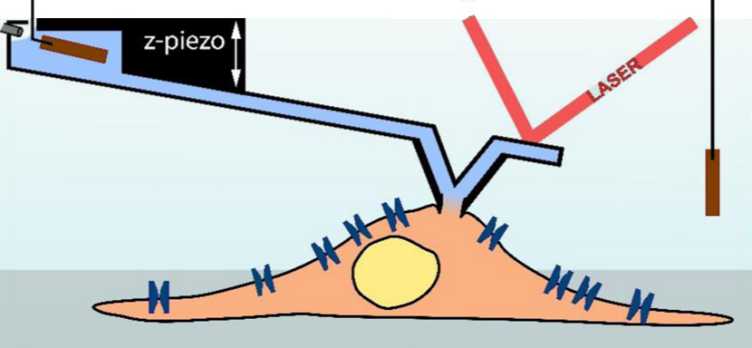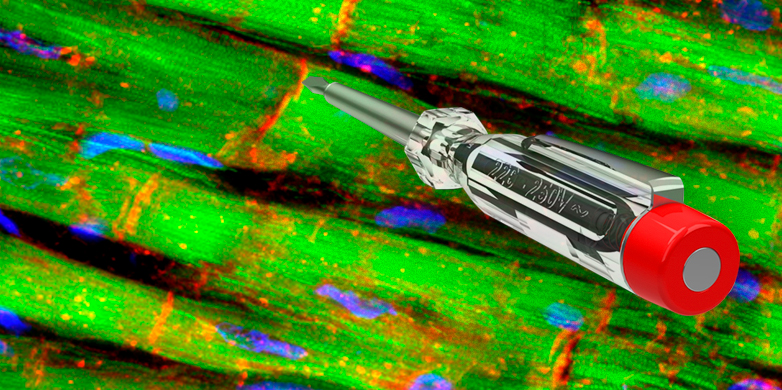Voltage tester for beating cardiac cells
For the first time, scientists have succeeded in recording the current in membrane channels of contracting cardiac cells. To do this, the scientists combined an atomic force microscope with a widely used method for measuring electrical signals in cells.
Electrical impulses play an important role in cells of the human body. For example, neurons use these impulses to transmit information along their branches and the body also uses them to control the contraction of muscles. The impulses are generated when special channel proteins open in the outer envelope of the cells, allowing charged molecules (ions) to enter or exit the cell. These proteins are referred to as ion channels. Since the 1970s, a method has been available to researchers that enables measurement of the activity of these channels, but until now this method has been used primarily on cells that do not move. Electrical engineers at ETH Zurich and biologists from the University of Bern have now developed the method further, so that they can easily record the activity of moving cells, such as beating cardiac muscle cells in a tissue cultre dish.
The existing method involves positioning a glass pipette against the outer membrane of a cell. The opening at the tip of the pipette is so small that it touches only a fraction of the cell surface. Ideally, this tiny patch of cell membrane has exactly one ion channel. The inside of the pipette is filled with a conductive fluid and an electrode, which makes it possible to measure differences in the charge between the outer part of the cell and cell interior (i.e. an electric potential ) and temporary changes in this potential resulting from activity in the ion channels. The method is referred to as the patch-clamp technique because the pipette is used to clamp a patch of the cell membrane.
Atomic force microscope with micro needle

Lead by Tomaso Zambelli, a lecturer at the Institute of Biomedical Engineering at ETH Zurich, and Hugues Abriel, a professor at the Department of Clinical Research at the University of Bern, the researchers have now combined this technique with an atomic force microscope. A sensor tip is seated on a movable mount – a so called cantilever – to scan the surface of the microscopic object. Several years ago, the researchers succeeded in producing sensor tips with an internal channel, which allows the computer-controlled injection of molecules into a cell. This technique is now being marketed by the ETH spin-off Cytosurge. However, the scientists continued development of this technique by fitting the micro-injection needle with an electrode to carry out patch-clamp measurements. The researchers have now published the successful results of this venture in the journal Nano Letters.
The patch-clamp technique is not only a central method for basic research in cell biology, it is also used routinely in the development of new drugs. For example, the pharmaceutical industry is legally required as part of the approval process for new drugs to test whether these drugs interact with ion channels. A drug that blocks ion channels may cause severe cardiac dysrhythmia in patients, which should be avoided at all costs.
Longer measurements and automation possible
In the case of the conventional patch-clamp technique, an operator manually positions the pipette against the cell; although automated procedures exists, their applications are limited. Thus, the cells under test must have the same size and shape and must not move (as cardiac cells do).
In the case of the new method, the micro-needle is controlled by a computer using force measurements from the atomic force microscope to hold it at a constant short distance from the cell surface. “This makes the contact between the needle and cell much more stable, which allows us to take measurements over a longer period of time and even test moving cells,” explains Zambelli. For the first time, researchers have thus succeeded in measuring electric potential changes in the ion channels of beating cardiac cells. Zambelli says he can also imagine using this as a foundation for development of an automated method for testing any cell, regardless of its shape or size.
Literature reference
Ossola D, Amarouch MY, Behr P, Vörös J, Abriel H, Zambelli T: Force-Controlled Patch Clamp of Beating Cardiac Cells. Nano Letters, 2 February 2015, doi: external page 10.1021/nl504438z

Comments
So what was the current measurement? This is huge?
Beautiful data and inspiring results. Congratulations to the authors.